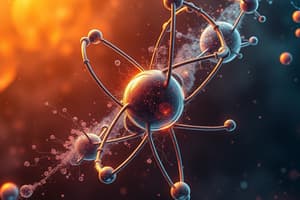Podcast
Questions and Answers
What is the main function of enzymes in cellular reactions?
What is the main function of enzymes in cellular reactions?
- Act as substrates
- Decrease activation energy (correct)
- Denature proteins
- Increase activation energy
Where do most enzymes have a unique 3-dimensional structure?
Where do most enzymes have a unique 3-dimensional structure?
- Mitochondria
- Cell membrane
- Active site (correct)
- Cytoplasm
What type of inhibitor competes for occupation of the active site of an enzyme?
What type of inhibitor competes for occupation of the active site of an enzyme?
- Competitive inhibitor (correct)
- Negative allosteric inhibitor
- Positive allosteric inhibitor
- Noncompetitive inhibitor
In which organelle does the citric acid cycle occur?
In which organelle does the citric acid cycle occur?
What is the net production of ATP molecules at the end of glycolysis?
What is the net production of ATP molecules at the end of glycolysis?
Which stage of cellular respiration occurs within the mitochondria?
Which stage of cellular respiration occurs within the mitochondria?
Which subatomic particle has a positive charge?
Which subatomic particle has a positive charge?
In an oxidation-reduction reaction, which structure is considered reduced?
In an oxidation-reduction reaction, which structure is considered reduced?
What is the principal molecule for storing and transferring energy in cells?
What is the principal molecule for storing and transferring energy in cells?
Which particle is much smaller than protons and carries a negative charge?
Which particle is much smaller than protons and carries a negative charge?
What happens to ATP when a phosphate group is removed by breaking a phosphoanhydride bond?
What happens to ATP when a phosphate group is removed by breaking a phosphoanhydride bond?
Which structure is compared to storing money in a bank due to its role in cellular energy?
Which structure is compared to storing money in a bank due to its role in cellular energy?
Study Notes
Enzymes and Catalysis
- Enzymes act as catalysts in cellular reactions, speeding up biochemical processes by lowering activation energy.
- Most enzymes possess a unique 3-dimensional structure which is crucial for their specific function and interaction with substrates.
Enzyme Inhibition
- Competitive inhibitors occupy the active site of an enzyme, thereby preventing substrate binding and hindering enzymatic activity.
Cellular Respiration
- The citric acid cycle occurs in the mitochondria, where it plays a key role in the oxidation of acetyl-CoA to produce energy carriers.
- Glycolysis generates a net production of 2 ATP molecules per glucose molecule.
- The electron transport chain, a stage of cellular respiration, occurs within the mitochondria, utilizing NADH and FADH2 produced in previous stages.
Atomic Structure
- Protons, found in the nucleus of an atom, carry a positive charge.
- Electrons are significantly smaller than protons and possess a negative charge, orbiting around the nucleus.
Oxidation-Reduction Reactions
- In oxidation-reduction reactions, the structure that gains electrons is deemed reduced, while the one that loses electrons is oxidized.
Energy Storage and Transfer
- ATP (adenosine triphosphate) is the principal molecule for storing and transferring energy within cells, serving as a universal energy currency.
- When a phosphate group is removed from ATP by breaking a phosphoanhydride bond, ATP is converted into ADP (adenosine diphosphate), releasing energy.
- Mitochondria are analogous to a bank for cellular energy, as they store ATP and manage energy production through various metabolic processes.
Studying That Suits You
Use AI to generate personalized quizzes and flashcards to suit your learning preferences.
Description
Test your knowledge on atomic structure, ATP as the 'energy currency' of cells, and oxidation-reduction reactions where electrons are exchanged between chemical structures.




